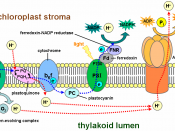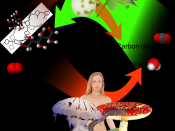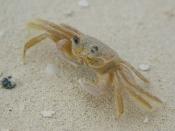- -
PHOTOSYNTHESIS
General Info
Defn: 'To make with light'
Reactants (Ingredients)
CO2, H2O, Sunlight, chlorophyll
Products
Food (C6H12O6 = glucose) and O2
Overall Reaction
Photosynthesis is actually a series of two reactions.
Light reactions (require sunlight)
chlorophyll uses sunlight to split water and form oxygen and chemical energy.
Dark reactions (don't require light)
use chemical energy from light reaction to convert carbon dioxide into glucose.
Where does photosynthesis take place?
Structure of a Chloroplast
Chlorophyll
Light
chlorophyll absorbs red, orange, blue and violet, and use the energy of light to do work.
The light reactions
occur on the surface of the thylakoid membrane.
The chemistry of light reactions
Dark reactions
occurs in the stroma
also called the, 'Calvin-Benson Cycle'
The energy to do all this work comes from the light reactions.
Chemistry of dark reactions
Overall reaction combining separate light and dark reaction equations.
CELLULAR RESPIRATION
General Info
Definition: Breaking down food (glucose) to get energy.
Every step of this pathway is controlled by enzymes.
Overall Chemical Equation:
Glucose is broken down and energy is formed in a three step process.
Glycolysis
Glucose broken down to form 2 three carbon molecules
Kreb's Cycle
three carbon molecules are broken down to 3 carbon dioxide molecules
Electron Transport
protons generated in two previous steps are with oxygen to make water and ATP.
Glycolysis (nine step process)
Takes place in the cytoplasm of a cell.
Doesn't require oxygen.
2 ATP are needed to begin this reaction, but 4 ATP are made, therefore 2 ATP is the net yield.
Glucose (6-carbon) is broken down into 2 pyruvic acid molecules (3-carbon).
Chemical Overview
If oxygen levels are still low, there are two options:
In mammals:
In yeast and bacteria:
If oxygen is available then pyruvic acid enters the Kreb's Cycle.
Kreb's Cycle
Takes place...



Biology
this has some good study notes, i like how the steps are in order, makes it easier to follow. its all good, but to improve the essay there should be more definitions of some of the topic words. i only counted 2. however it was extremely helpful with my work. some valid points. thanx
0 out of 0 people found this comment useful.